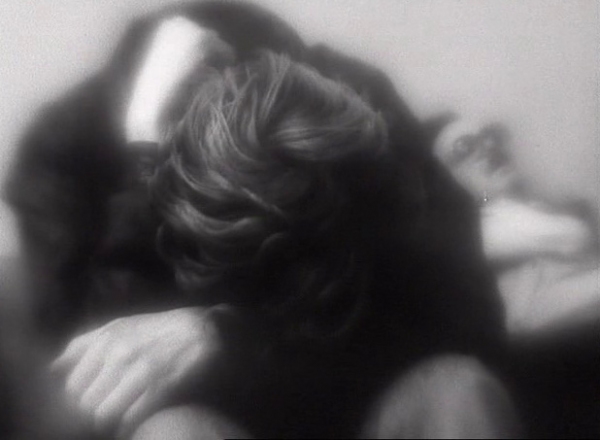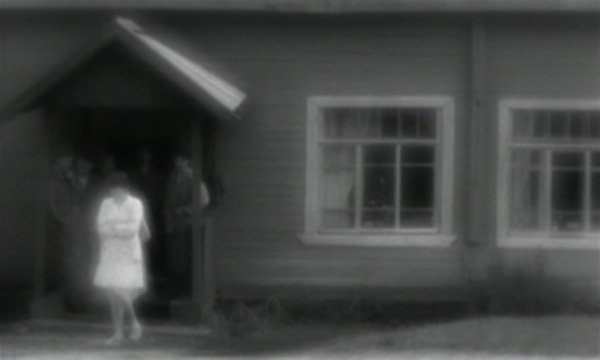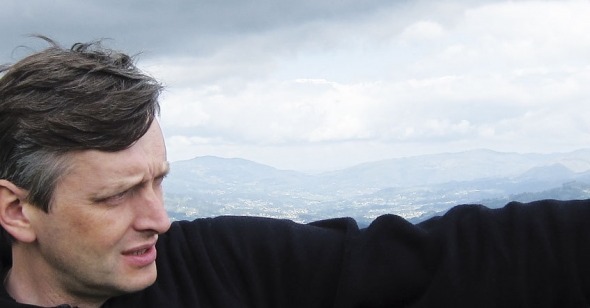Earth, Sky, and Steel:
The Cinema of Sergei Loznitsa
by Michael Pattison
Though Sergei Loznitsa has made eighteen films since 1996, delineating a logical arc in his career—as one might have attempted to do during a full retrospective at Crossing Europe Filmfestival Linz this past April—isn’t easy. First, there’s the question of duration. Though the Belarus-born Ukrainian has made five feature-length films, each was produced between other projects ranging from seventeen minutes to an hour—so there’s no easy way to discern, say, an “early shorts” phase from a feature-making period. Second, there’s the question of format. When Loznitsa’s first narrative feature, My Joy, premiered at Cannes in 2010, he already had a reputation as a dedicated experimental documentarian. Though he’s made one more narrative feature since then (2012’s In the Fog), Loznitsa has also returned to nonfiction work, most notably with Maidan, last year’s epic account of Kiev’s anti-government uprising during the 2013-2014 winter. Third, style. Across the documentaries alone, there are dramatic departures, from the intimate to the detached, from playfully experimental yet accessible work to that bordering on installation-style abstraction, from commissioned snapshots of particular places to repurposed found-footage narratives.
Loznitsa doesn’t appear to prefer certain works, or kinds of works, over others. In his three best-known films, he shows himself to be—all at once—an artist, a documentarian, an ethnographer, a historian, and a storyteller. In My Joy, a disturbing and powerful road movie of sorts, an unassuming long-distance truck driver encounters violent hostilities and petty bureaucracies in Russia’s rural backwaters—a territory whose social tensions are conditioned by past atrocities. In the Fog, an adaptation of a 1989 novel by Belarusian writer Vasil Bykov, sees a humble villager along the western frontier of German-occupied USSR wrongly accused by partisan friends of collaborating with the Nazis—juxtaposing events following this charge with those leading up to it. For Maidan, Loznitsa and his crew of cameramen capture a ground-level perspective of Kiev’s would-be peaceful antigovernment protests that escalated into an ultimately deadly conflict following the violent dispersal of civilians by police; opening with shots of a hopeful, peaceful assembly, the film concludes with a nighttime funeral march for the hundreds of victims.
If each of the roles Loznitsa fulfills is discernible at various moments across these three films, however, all of them find their most concentrated form in the two works that are perhaps least likely to be cited when one summarizes their director’s oeuvre: Blockade (2005) and Revue (2008), both of which consist entirely of footage from old Soviet propaganda reels, reassembled with additional, newly recorded soundtracks. Though these films may appear anomalous alongside his more straightforwardly defined documentary and fiction works, his career-long thematic preoccupations are already here: Russia and its immediate neighbors—their landscape, their recent histories and the finer points of daily life defined by and closely bound to them; the rituals and customs that emerge and play out there; life as the summation and interplay of extreme conditions (geographical, industrial, political, social) experienced by ordinary people.
In Blockade, we find Maidan’s narrative seeds. Without voiceover, music, or much else in the way of emotive or explanatory techniques, the film assembles first-hand filmic accounts of the Nazis’ 872-day siege of Leningrad (now St. Petersburg) into one unsettlingly coherent narrative, from the city’s preparatory defense measures in 1941 to the public hanging of captured German perpetrators after it was finally thwarted in 1944. Like Maidan—whose narrative similarly flows from the helpless perspective of a participating witness, as nonviolent social gatherings give way to frissons with police and, finally, death in the streets—the emotional knockout of Blockade is cumulative, as the sound of wintry winds lends a coarse whisper through previously busy boulevards that are now marked by the roadside bodies of the starved and perished. These eerie, icy streets contain the same sense of dread as the scantily populated roads in My Joy. So long as Russia can’t reconcile, it is implied, the social and political tensions prevailing within and around its current borders with a deeper understanding of its historical violence, things will not—cannot—end well.
Loznitsa’s films depict people as social beings, focused as they are upon landscape and the cyclical rhythms of labor derived from it. A large part of this also has to do with the elements—with the seasons and the weather—that still condition the working patterns of a great number of Russians. Today We Are Going to Build a House (1996) and Life, Autumn (1998), Loznitsa’s first two films (both made with Kazakh director Marat Magambetov), are good examples. The former opens with two shots, of the sky and of a puddle—heaven and earth—before depicting a day’s collective work on a construction site, returning repeatedly to the sky and to the puddle to show meteorological fluctuations. A home is gradually erected, though all the action is captured from afar; such sequences feel like reels of establishing shots lifted from instructional documentaries, stitched together in such a way that they acquire their own sense of poetry. In Life, Autumn, village life near Smolensk in western Russia is presented as a collective ritual, by way of a series of titled vignettes (“Friends,” “The Brother,” “The Groom,” and so on) edited to the sounds of local folk music. In one shot, a villager plays the accordion as snowflakes fall gently upon him.
Loznitsa’s preoccupation with far-flung locales is evident in both tripod-fixed landscape shots, which capture topographical minutiae, and vehicle-mounted traveling shots, which heighten every little bump when moving across the muddied, contoured terrain. Both types of shot permeate everything from The Settlement (2001), a beautiful and ambiguous document of a labor-oriented therapy camp (and his first foray into feature-length filmmaking), to My Joy. During one Q&A in Linz, Loznitsa talked with some glee of the possibility of traveling 11,000km along the same road and in the same direction in Russia (“It cleans your brain, first of all”), and of his twelve-hour, 700km car journey from Moscow to St. Petersburg (“You meet a lot of interesting people”). Such treks no doubt affect one’s sense of time as well as space, which might account for why so many of Loznitsa’s films emphasize those everyday longueurs that define life outside urban metropolises.
The Train Stop (2000), his first solo short, takes place entirely inside a railway station’s waiting room, opening with abstract visuals and the cacophonous hiss of a steam engine before establishing its rhythm, which comes from dreamily shot images of people sleeping on benches, their breathing and snoring competing in tranquil discord with buzzing flies, creaky floors, and far-off winds. In Landscape (2003), Loznitsa creates a continually moving panorama, panning first through the residential areas of a small Russian town in winter and then along a seemingly endless line of people queuing at a bus stop. Loznitsa zooms in on his line of unsuspecting subjects, and we hear a repeated refrain, from no one in particular: “I wouldn’t want to miss the bus.” Later, another remarks, “We were all waiting peacefully, now it’s like a rugby scrum.”

In several ways, Landscape appears to be a conscious departure from its director’s preceding short, Portrait (2002), not only in the difference its title implies but also in the way the single left-to-right camera movement (across the surface of a flowing river) of the earlier film is here promoted to chief structuring principle. Whereas the distance between camera and subjects is made apparent in Landscape both by the crowd’s lack of engagement with the camera and by those brief moments in which people pass in front of the lens and block our view, Portrait documents the inhabitants of a rural town in a kind of suspended performance, living tableaux vivants. This feigned motionlessness becomes the real thing in Reflections (2014), Loznitsa’s second of three shorts commissioned as part of portmanteau projects (on this occasion, by Sarajevo Film Festival), in which scenes of present-day Sarajevo are reflected, literally and figuratively, in the glass panes covering stills from 1992 by Bosnian photographer Milomir Kovačević, of partisans fighting against the siege of Sarajevo.
Though we might say Loznitsa subscribes to the notion that if you shoot a single space long enough its mysteries will reveal themselves, his establishing shots aren’t especially or noticeably long in duration. Rather, it is when such shots are combined in relation to one another that a sense of place is built. This is the case in The Miracle of St. Anthony (2012), the first of his omnibus shorts (initiated by Vila do Conde Short Film Festival), for which he attended a centuries-old religious ceremony that sees inhabitants of a village in northern Portugal gather to have their livestock and pets blessed by the local priest. Loznitsa begins to detail the event with the same distanced observational takes later employed in Maidan, revealing an all-ears, all-eyes respect for every aspect of the ritual while never outstaying his welcome in any single part of it.
The director’s genuine if bemused appreciation for the ceremony’s more eccentric qualities is best embodied by a shot of horses lining up to receive a drizzle of holy water. It’s the way Loznitsa’s unmoving camera privileges a relatively narrow vantage point, so that the horses come and go apparently ad infinitum, with audiences kept out of the loop as to when—or if—this increasingly absurd succession will end. Spend enough time in what might otherwise be a peculiar space, however, and its particularities become relatable: Loznitsa shows how something as mundane as a shift in weather can bring out smaller, more universal rituals, when a group of men huddles beneath umbrellas to the sound of rain and thunder, seemingly putting the (strange) holy proceedings on hold in order to escape a (more relatable) rainfall.
For mid-length documentary Northern Light (2006), Loznitsa spent time in the claustrophobic home of a three-generation family in Sumskoy Posad, a village on the shores of the White Sea. In terms of setting, this is perhaps the most extreme of Loznitsa’s ethno-geographical dispatches: harsh subzero temperatures and fleeting windows of daylight are endured by one family whose days are based around a humdrum cycle of wood-cutting, cow-milking, truck-driving, knitting, watching television, and sleeping. Though Maidan’s tripod-fixed views are anticipated here in exterior shots of the central family’s farm, interiors unfold from slightly more ad hoc set-ups, such as those scenes in which we view the milking of a cow from beneath the animal itself (its udder silhouetted against an LED nightlight) or those in which the family hosts a party for its two young children and their friends. While the handheld camerawork speaks to Loznitsa’s versatility as an artist—developing styles to match subjects, rather than imposing a singular approach onto them—the palpable trust on his subjects’ parts (particularly the children, who don’t appear to be at all perturbed by the filmmaker’s presence) speaks of his tact and intelligence as a documentarian.
To say not a great deal happens in The Settlement is to be doubly correct. About nine minutes into this 80-minute documentary, Loznitsa films an axe being brought down repeatedly onto a trunk, without any wood actually being cut. Soon after, a man receives a hair cut, though in the dim lighting, the silhouetted dome of the recipient suggests he’s already bald. Later, a group of workers harvests grain without any direction or purpose. These are just the first clues that the labor being carried out at this rural camp isn’t labor in the traditional sense, but rather a form of therapy—a performative routine that becomes ritualized by virtue of its repetition and collective context: though the film doesn’t tell us itself, this is a mental institution located in an idyllic Russian woodland. Again, Loznitsa both sets the scene and bookends it by focusing on the more specific timbres of the environment at hand with shots of skies, lifting fog, dramatic clouds. An early dissolve, from thick fog crawling across a mysterious landscape to arrow-straight sunrays illuminating a farmhouse, recalls the hokey exposition of a 1930s Universal horror film; add to this the film’s overexposed monochrome cinematography, and the resulting atmosphere is suggestive of a disquieting fiction film rather than an observational documentary.
Indeed, Loznitsa has consistently tempered his observational documentary style with more stylized flourishes. In drawing attention to these, he invites us to question and/or engage with his films as constructs, so that they themselves might double as comments on the ethics and strategies of nonfiction as a whole. Consider the tableaux vivants in Portrait, or the lingering cuts-to-black that chop the likes of Blockade into distinct episodes. In The Old Jewish Cemetery (2014)—the third of his omnibus shorts (commissioned as part of Riga’s European Culture Capital initiative)—a fragmentation of space means that we too must participate in its (re)construction, must be as quietly investigative as the film itself. Whereas any pictorial representation of the cemetery suggests a pleasant and unremarkable vicinity—with the camera capturing tourists and locals involved in banal conversations—the eponymous graveyard (built in Riga in 1725) was used as a mass burial site by the occupying Nazis during WWII.
Such history must be actively dug out, and the film is structured accordingly: retaining his observational, narrationless style, Loznitsa imposes tension, even mystery, upon the space by splintering it. When the director shoots a plaque dedicated to the thousands of Jews killed at or near to the site so that only a few words are seen at a time (“…removed and used…,” “…cemetery collapse…,” and, most poignantly, “,000 Jews killed”), we must work to piece together the half-hidden history that any other ordinary snapshot of the space would fail to include. In these fragmented moments, The Old Jewish Cemetery also rhymes with the multiple viewpoints put forth and numerous deaths recorded in Maidan—and even with those moments in which My Joy and In the Fog present flashbacks, to jolt their narratives and transform the meanings of their ongoing present-day stories. Only gradually, these films seem to argue, by spending time in a space and by viewing it not from a single perspective but from several, can a fuller sense of its meaning be gleaned.
Like The Settlement and Today We Are Going to Build a House, The Letter (2012) and Artel (2006) look like they could have been assembled from the same vaults as Loznitsa’s archive films. Though The Letter’s diffused lighting and black-and-white cinematography might evoke a faded, eerie silent-era print, we know that this is a constructed, contemporary aesthetic because of the gently evocative maximalism of its soundscape: the flapping of linen, a crash of thunder, a neighing horse, and a distant, howling train. Such sonic elements combine throughout with the muffled murmurs of Loznitsa’s human subjects—who, like those of The Settlement, are inhabitants of a mental institution, shot so as to resemble apparitions, white silhouettes against a forbiddingly shadowy landscape. Those in Artel are the stark opposite: the men are black forms against a brilliant icescape in northern Russia, going about an age-old ritual (fishing) with an incongruously modern instrument (chainsaw).

Loznitsa addresses the subject of cyclical work most directly in his thirty-minute short Factory (2004). Though mostly set in industrial interiors—first in a steelworks in the Urals whose workforce is entirely male, second in a neighboring clay mill whose employees are all seemingly female—this still feels very much like one of its director’s landscape films, something heightened by the gorgeously framed wide shots that open and conclude it. Filmed in much closer confines than anything seen in Artel or The Settlement, or even the domestic space of Northern Light, Factory is a much more concentrated engagement with labor as a grueling everyday ritual. Though Loznitsa cites the accomplished technicians behind the black-and-white factory scenes repurposed in Revue as an influence, the deep, contrasting hues of Nikolai Evimenko and Sergei Mikalchuk’s color cinematography in Factory have more in common with the exquisitely detailed nitrate-shot footage of those bedazzlingly colorful steelworks documentaries made under government sponsorship in 1940s Britain.
Those films too—including Ronald H. Riley and Jack Cardiff’s Technicolor masterpiece Steel (1945)—dared to conceptualize the burdens of daily work with a saturated palette, as if that might transform the world into something less unpleasantly monotonous. Speaking of which, for all its aesthetic achievements, Factory also contains a shot that perhaps speaks for Loznita’s inquisitive, evocative, and empathetic artistry most economically: between throwing an endless stream of clay bricks onto a vertical assembly line, one woman indulges in the gentlest of sighs—the smallest and most human of gestures that punctuates the almost involuntary bodily movements such a task entails. In Loznitsa, the world is a harsh and even unforgiving place—but at its center, we find ingenuity, resilience, and survival.
